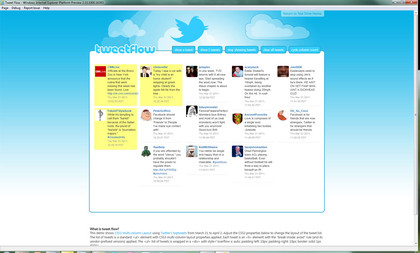What IE10 tells us about Windows 8
IE10 isn't just about keeping up with Chrome
That means that Microsoft isn't resting on its laurels and waiting until IE9 is obsolete; it's going to carry on adding new features and new web standards support, it's going to keep previewing the next version of the browser engine for web developers - but it's not going to bring out a new beta of IE with a new interface for quite some time.
By the time we see the new IE10 interface, we might have already seen the Windows 8 interface it's going to live inside. If you're thinking of the minimal 'immersive' interface for IE on tablets that has been leaked recently, that ties up well with some of the new standards coming in IE10 like CSS3 grid, flexbox and multicolumn layout features which make it easier to lay out web pages that adapt to different size screens - like tablets (and TVs).

IE10 AND CSS: Hardware acceleration on Windows and ARM, plus the standards that will make for good tablet Web apps
IE10 Platform Preview
Platform Preview 1 is out now; the next platform preview will come in eight to twelve weeks, rather than the eight weeks between IE9 platform previews. Hachamovitch saying faster releases "just means bigger version numbers and more updates of incomplete standards" is presumably a jab at Chrome (there were a number of those in the keynote, proving that Microsoft is taking Chrome and Chrome OS seriously).
More interestingly, he also says taking more time between previews is "just more effective for making real progress with community given the time it takes to work through the issues you report."
It's not just a question of bugs to fix (although Sinofsky made a point of showing that some other browsers still don't implement the CSS3 browser radius standard correctly).
Sign up for breaking news, reviews, opinion, top tech deals, and more.

THINK TILES: The multicolumn standard will make resizable web apps fit well on Windows 8 ARM tablets
Some new standards going into IE10 like flexbox and grid layout are still under development. Instead of waiting until the other browsers have implemented them and the feedback from developers has gone into a final standard the way it has often done in the past, the IE team is implementing these prospective standards, getting the feedback and working with the W3C to get standards that suit the direction Microsoft wants to go in.
Web developers and browser vendors who once lamented that Microsoft didn't engage with web standards may feel you should be careful what you wish for. Microsoft isn't ignoring web standards in IE10 and Windows 8; it's helping drive them.
Mary (Twitter, Google+, website) started her career at Future Publishing, saw the AOL meltdown first hand the first time around when she ran the AOL UK computing channel, and she's been a freelance tech writer for over a decade. She's used every version of Windows and Office released, and every smartphone too, but she's still looking for the perfect tablet. Yes, she really does have USB earrings.